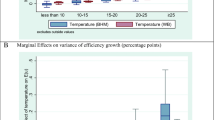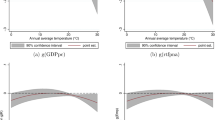Abstract
In this study, the interrelationships between global climate change and EU countries’ GDP, investments, R&D expenditures, innovations, and labor productivity indicators are discussed. Global temperature anomalies are adopted as an indicator of climate change and the relationsgip estimated with the panel vector autoregreesion (PVAR) approach for the period from 1996 to 2018. Results suggest that an increase in atmospheric temperature has negative effect on economic growth, investment, and labor productivity. However, an increase in atmospheric tempetrature increases patent applications by 0.4% in the long run. Moreover, while economic growth and investments trigger temperature anomalies, labor productivity has a negative effect on atmospheric temperature. The long-run coefficient estimation results are confirmed by analysis, and the existence of strong dynamic relationships between the variables is determined. Impulse–response graphs differ from these results and emphasize that the effects caused by shocks should be considered temperature anomalies and EU’s technological and economic developments.



Similar content being viewed by others
Notes
Austria, Belgium, Bulgaria, Croatia, Cyprus, Czech Republic, Denmark, Estonia, Finland, France, Germany, Greece, Hungary, Italy, Latvia, Lithuania, Luxembourg, Malta, Netherlands, Poland, Portugal, Romania, Slovak Rep., Slovenia, Spain, and Sweden. Ireland was excluded as patent application data are not available.
References
Abrigo, M. R., & Love, I. (2016). Estimation of panel vector autoregression in Stata. The Stata Journal, 16(3), 778–804.
Adedoyin, F. F., Alola, A. A., & Bekun, F. V. (2020). An assessment of environmental sustainability corridor: The role of economic expansion and research and development in EU countries. Science of the Total Environment, 713, 136726.
Alola, A. A., & Kirikkaleli, D. (2020). Global evidence of time-frequency of temperature and environmental quality from a wavelet coherence approach. Air Quality, Atmosphere & Health, 14, 581–589.
Alola, A. A., Akadiri, S. S., Akadiri, A. C., Alola, U. V., & Fatigun, A. S. (2019). Cooling and heating degree days in the US: The role of macroeconomic variables and its impact on environmental sustainability. Science of The Total Environment, 695, 133832.
Akadiri, S. S., Alola, A. A., Alola, U. V. & Nwambe, C. S. (2020). The role of ecological footprint and the changes in degree days on environmental sustainability in the USA.
Akadiri, S. S., Alola, A. A., Akadiri, A. C., & Alola, U. V. (2019). Renewable energy consumption in EU-28 countries: Policy toward pollution mitigation and economic sustainability. Energy Policy, 132, 803–810.
Annicchiarico, B., & Dio, F. D. (2015). Environmental policy and macroeconomic dynamics in a new Keynesian model. Journal of Environmental Economics and Management, 69, 1–21.
Annicchiarico, B., & Dio, F. D. (2017). GHG emissions control and monetary policy. Environmental and Resource Economics, 67, 823–851.
Bannor, F., Dikgang, J., Kutela Gelo, D. (2021). Interdependence between research and development, climate variability and agricultural production: Evidence from sub-Saharan Africa. MPRA Paper No. 105697, https://mpra.ub.uni-muenchen.de/105697/, (05.01.2022).
Bansal, R., & Ochoa, M. (2011). Welfare costs of long-run temperature shifts. NBER Working Paper, 17574.
Bayarçelik, E. B., & Taşel, F. (2012). Research and development: Source of economic growth. Procedia-Social and Behavioral Sciences, 58, 744–753.
Bekun, F. V., Alola, A. A., & Sarkodie, A. S. (2019). Toward a sustainable environment: Nexus between CO2 emissions, resource rent, renewable and nonrenewable energy in 16-EU countries. Science of the Total Environment, 657, 1023–1029.
Bilbao-Osorio, B., & Rodríguez-Pose, A. (2004). From R&D to innovation and economic growth in the EU. Growth and Change, 35(4), 434–455.
Brini, R. (2021). Renewable and non-renewable electricity consumption, economic growth and climate change: Evidence from a panel of selected African countries. Energy, 223, 120064.
Campell, A., & Nekeisha, S. (2021). The macroeconomic impact of extreme weather: Evidence from Jamaica. International Journal of Disaster Risk Reduction, 61, 102336.
Canova, F. & Ciccarelli, M. (2013). Panel vector autoregressive models: A survey. ECB Working Paper, No. 1507.
Chen, C., Pan, D., Huang, Z., & Bleischwitz, R. (2021). Engaging central banks in climate change? The mix of monetary and climate policy. Energy Economics, 103, 105531.
Colacito, R., Hoffman, B., & Phan, T. (2019). Temperature and growth: A panel analysis of the United States. Journal of Money, Credit and Banking, 51(2-3), 313–368.
Copeland, B. R. (2009). Globalization and the environment. Kym Anderson, University of Adelaide Press.
Copernicus (2021). 2020 warmest year on record for Europe; globally, 2020 ties with 2016 for warmest year recorded, (Accessed 09 December 2022).
Copernicus (2022). Climate indicators temperature, (Accessed 09 December 2022).
Danish, O., & B., Ulucak, R. (2021). An empirical investigation of nuclear energy consumption and carbon dioxide (CO2) emission in India: Bridging IPAT and EKC hypotheses. Nuclear Engineering and Technology, 53, 2056–2065.
Dasgupta, S., Maanen, N. V., Gosling, S. N., Piontek, F., Otto, C., & Schleussner, C.-F. (2021). Effects of climate change on combined labour productivity and supply: An empirical, multi-model study. Lancet Planet Health, 5, 455–465.
Dell, M., Jones, B. F., & Olken, B. A. (2012). Temperature shocks and economic growth: Evidence from the last half century. American Economic Journal: Macroeconomics, 4(3), 66–95.
Dell, M., Jones, B. F., & Olken, B. A. (2014). What do we learn from the weather? The new climate-economy literature. Journal of Economic Literature, 52(3), 740–798.
Deschênes, O., & Greenstone, M. (2007). The economic impacts of climate change: Evidence from agricultural output and random fluctuations in weather. The American Economic Review, 97(1), 354–385.
Dietz, S., & Stern, N. (2015). Endogenous growth, convexity of damage and climate risk: How Nordhaus’ framework supports deep cuts in carbon emissions. The Economic Journal, 125, 574–620.
Donadelli, M., Grüning, P., Jüppner, M., & Kizys, R. (2021). Global temperature, R&D expenditure, and growth. Energy Economics, 104, 105608.
Donadelli, M., Jüppner, M., Riedel, M., & Schlag, C. (2017). Temperature shocks and welfare costs. Journal of Economic Dynamics & Control, 82, 331–355.
Eurostat (2021). R&D expenditures, (Accessed 09 December 2022).
Fankhauser, S., & Tol, R. S. J. (2005). On climate change and economic growth. Resource and Energy Economics, 27, 1–17.
Fenichel, E. P., Levin, S. A., McCay, B., Martin, K. S., Abbort, J. K., & Pinsky, M. L. (2016). Wealth reallocation and sustainability under climate change. Nature Climate Change, 6(3), 237–244.
Fischer, C., & Springborn, M. (2011). Emissions targets and real business cycle: Intensity targets versus caps or taxes. Journal of Environmental Economics and Management, 62, 352–366.
Fishman, R., Carrillo, P., & Russ, J. (2019). Long-term impacts of exposure to high temperatures on human capital and economic productivity. Journal of Environmental Economics and Management, 93, 221–238.
Freimane, R., Balina, S. (2015). Research and development expenditures and economic growth in EU: a panel data analysis. 56th International Riga Technical University Conference SCEE’2015 Proceeding, ISBN: 978-9934-8275-3-2.
Ganelli, G., & Tervala, J. (2011). International transmission of environmental policy: A new Keynesian perspective. Ecological Economics, 70, 2070–2082.
Granger, C. W. J. (1969). Investing causal relations by econometric models and cross-spectral methods. Econometrica, 37(3), 424–438.
Guiteras, R. (2009). The impact of climate change on Indian agriculture. University of Maryland, College Park. September.
Hasiang, S. M. (2010). Temperatures and cyclones strongly associated with economic production in the Caribbean and Central America. Sustainability Science, 107(35), 15367–15372.
Heutel, G. (2012). How should environmental policy respond to business cycles? Optimal policy under persistent productivity shocks. Review of Economic Dynamics, 15, 244–264.
Hillebrand, E., & Hillebrand, M. (2019). Optimal climate policies in a dynamic multi-country equilibrium model. Journal of Economic Theory, 179, 200–239.
Im, K. S., Pesaran, M. H., & Shin, Y. (2003). Testing for unit roots in heterogeneous panels. Journal of Econometrics, 115(1), 53–74.
IPCC. (2021). Climate change 2021: The physical science basis. Contribution of Working Group I to the Sixth Assessment Report of the Intergovernmental Panel on Climate Change. Cambridge University Press.
Kacprzyk, A., & Świeczewska, I. (2019). Is R&D always growth-enhancing? Empirical evidence from the EU countries. Applied Economics Letters, 26(2), 163–167.
Kahn, M. E., Mohaddes, K., & Ng, R. N. C. (2021). Lon-term macroeconomic effects of climate change: A cross-country analysis. Energy Economics, 104, 105624.
Kober, T., Summerton, P., Pollitt, H., Chewpreecha, U., Ren, X., Wills, W., Octaviano, C., McFarland, J., Beach, R., Cai, Y., Calderon, S., Fisher-Vanden, K., & Rodriguez, A. N. L. (2016). Macroeconomic impacts of climate change mitigation in Latin America: A cross-model comparison. Energy Economics, 56, 625–636.
Levin, A., Lin, C. F., & Chu, C. S. J. (2002). Unit root tests in panel data: Asymptotic and finite-sample properties. Journal of Econometrics, 108(1), 1–24.
Lim, J.-S., & Kim, Y.-G. (2012). Combining carbon tax and R&D subsidy for climate change mitigation. Energy Economics, 34, 496–502.
Love, I., & Zicchino, L. (2006). Financial developments and dynamic investment behavior: Evidence from panel VAR. The Quarterly Review of Economics and Finance, 46(2), 190–210.
Nasir, M. A., Huynh, T. L. D. And Tram, H. T. X. (2019). Role of financial developments, economic growth & foreign direct investment in driving climate change: A case of emerging ASEAN. Journal of Environmental Management, 242, 131-141.
Newell, R. G., Prest, B. C., & Sexton, S. E. (2021). The GDP–temperature relationship: Implications for climate change damages. Journal of Environmental Economics and Management, 108, 102445.
Niemelä, R., Hannula, M., Rautio, S., Reijula, K., & Railio, J. (2002). The effect of air temperature on labour productivity in call centers-a case study. Energy and Buildings, 34, 759–764.
Nordhaus, W. D. (1991). To slow or not to slow: The economics of the greenhouse effect. The Economic Journal, 101, 920–937.
Pasimeni, F., Fiorini, A., & Georgakaki, A. (2021). International landscape of the inventive activity on climate change mitigation Technologies. A patent analysis. Energy Strategy Reviews, 36, 100677.
Rezai, A., Taylor, L., & Foley, D. (2018). Economic growth, income distribution, and climate change. Ecological Economics, 146, 164–172.
Salim, R., Hassan, K., & Rahman, S. (2020). Impact of R&D expenditures, rainfall and temperature variations in agricultural productivity: Empirical evidence from Bangladesh. Applied Economics, 52(27), 2977–2990.
Shafiei, S., & Salim, R. (2014). Non-renewable and renewable energy consumption and CO2 emissions in OECD countries: A comporative analysis. Energy Policy, 66, 547–556.
Su, H. N., & Moaniba, I. M. (2017). Does innovation respond to climate change? Empirical evidence from patents and greenhouse gas emissions. Technological Forecasting & Socail Change, 122(C), 49–62.
Van der Zwaan, B. C., Gerlagh, R., & Schrattenholzer, L. (2002). Endogenous technological change in climate change modelling. Energy Economics, 24, 1–19.
Zhang, H., Liu, C., & Wang, C. (2021). Extreme climate events and economic impacts in China: A CGE analysis with a new damage function in IAM. Technological Forecasting & Social Change, 169, 120765.
Zivin, J. G., & Neidell, M. (2014). Temperature and the allocation of time: Implications for climate change. Journal of Labor Economics, 32(1), 1–26.
Author information
Authors and Affiliations
Corresponding author
Additional information
Publisher’s Note
Springer Nature remains neutral with regard to jurisdictional claims in published maps and institutional affiliations.
Rights and permissions
Springer Nature or its licensor (e.g. a society or other partner) holds exclusive rights to this article under a publishing agreement with the author(s) or other rightsholder(s); author self-archiving of the accepted manuscript version of this article is solely governed by the terms of such publishing agreement and applicable law.
About this article
Cite this article
Aslan, A., Altinoz, B. & Polat, M.A. Investigation of the Sensitivity of EU Countries to Temperature Anomalies in Terms of Economic and Technological Indicators. J Knowl Econ (2023). https://doi.org/10.1007/s13132-023-01291-z
Received:
Accepted:
Published:
DOI: https://doi.org/10.1007/s13132-023-01291-z




